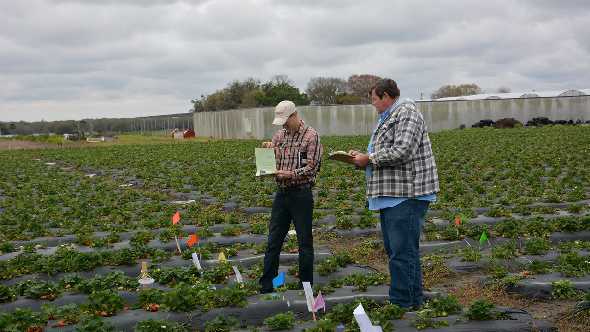Organic Strawberry Research Gets $200,000 Boost From Walmart
With an additional $200,000 grant from the Walmart Foundation, scientists from the University of Florida and North Carolina A&T University are expanding grower engagement in organic strawberry research.
While the focus of the 2013-2014 work was broad and exploratory, a key component of this year’s research will be to test the best aspects of the organic strawberry production system under farm conditions and with grower management.

UF/IFAS researcher Vance Whitaker (left) and Gerald Hubbell with JMAK Farms participate in a review of strawberry plants in Plant City.
Photo courtesy of UF/IFAS
Growers at three farms in North Central Florida are assessing two cover crops and three commercial strawberry cultivars that performed well in last year’s Phase I trials. Grower evaluations of the Phase I research resulted in suggestions that researchers assess cover crop combinations as well as a cover crop that could produce a marketable product.
In Phase II, scientists will evaluate the on-station and on-farm research for seasonal variability in market yield, nutrient-use efficiency, consumer acceptance and response to postharvest handling and storage.
Last year, two types of strawberry-growing systems were tested in North Carolina and Florida, one in open fields and one in a high tunnel. This approach allowed researchers to answer the kinds of questions that organic and conventional growers commonly face about how a change in one component of a farming system will affect other elements.
Although the high tunnel system tested in the initial study enhanced plant growth, fruit yield and frost protection, growers didn’t see it as important. UF researchers then focused on more in-depth studies of selected cultivars in the organic open-field system in Florida.
In Phase II, strawberry cultivar evaluation in an organic high tunnel system will continue only at North Carolina A&T University, where 10 cultivars will be evaluated, instead of the eight used last year. Additionally, four strawberry cultivars have been planted in a high tunnel as well as in the open field at the Hmong demonstration site in Lincolnton, North Carolina.
Pest management continues to be a major focus of the research.
Researchers are building on their Phase I work with the Twospotted spider mite and the spotted wing drosophila by investigating the susceptibility of three strawberry cultivars to infestation by the pests.
Since farmers’ markets and community supported agriculture are two important channels for small strawberry growers, researchers will conduct a national online consumer survey. It will focus on consumers’ preference of strawberry quality attributes and their willingness to pay for them.
In addition to increasing grower participation, researchers expect more engagement of county Extension agents in Phase II. By working with Extension faculty from Florida A&M University, minority and limited-resource farmers will be included in research evaluation activities and an on-farm workshop to be organized by Florida Organic Growers and Consumers Inc.
The Walmart Foundation is funding the research. UF and N.C. A&T received the $200,000 grant in 2014 in addition to the $175,000 awarded in 2013 to further evaluate the most promising innovations on area farms in addition to research stations in Florida and North Carolina.









